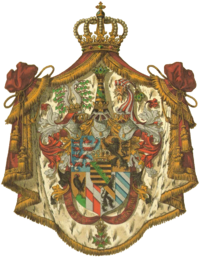- Coat of arms of Saxe-Weimar-Eisenach
-
The Coat of arms of the Grand Duchy of Saxe-Weimar-Eisenach was created in 1815 when the area was raised to the title of Grand Duchy, and ended between 1918 with the transition of Saxe-Weimar-Eisenach into the new state of Thuringia. The full grand ducal style was Grand Duke of Saxe-Weimar-Eisenach, Landgrave in Thuringia, Margrave of Meissen, Princely Count of Henneberg, Lord of Blankenhayn, Neustadt and Tautenburg, and this is represented in the arms:
- In the first quarter, the striped lion of Thüringia; [1][2]
- In the second quarter, the arms of the Margraviate of Meissen;[2]
- In the third quarter, the arms of the County of Hennenberg and of Neustadt-Arenshaugk;[2]
- In the fourth quarter, the arms of the Lord of Blankenhayn (Blankenheim) and Tautenb[o]urg;[2]
- Above all the arms of Saxony, as was tradition for the descendants of the Saxon line.[2]
It was used on the Grand Ducal Standard c.1862 - c.1878.[1]
References
- Saxe-Weimar-Eisenach on International Heraldry, accessed 2009-04-12.
- ^ a b Grand Ducal Standards until 1918 (Saxe-Weimar-Eisenach, Germany) at Flags of the World . Dated 2001/2002. Accessed 2009-05-25.
- ^ a b c d e Saxe-Weimar-Eisenach on Heraldique-Europeenne. Authored by Bunel, Arnaud. Accessed 2009-05-25. (French)
Coats of arms of states of the German Empire German coat of arms • German Empire (1871–1918) Kingdoms 
Grand duchies Duchies Anhalt • Brunswick • Saxe-Altenburg • Saxe-Coburg and Gotha • Saxe-MeiningenPrincipalities Lippe • Reuss Junior Line • Reuss Elder line • Schaumburg-Lippe • Schwarzburg-Rudolstadt • Schwarzburg-Sondershausen • Waldeck-PyrmontFree Imperial Cities Categories:- German coats of arms
Wikimedia Foundation. 2010.

